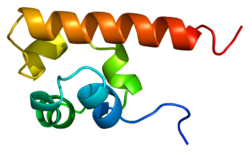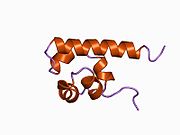EPH receptor A4
| edit |
| EPH receptor A4 | |||||||||||
|---|---|---|---|---|---|---|---|---|---|---|---|
 PDB prikaz baziran na 1b0x. | |||||||||||
| Dostupne strukture | |||||||||||
| 2LW8, 2WO1, 2WO2, 2WO3, 3CKH, 3GXU, 4BK4, 4BK5, 4BKA, 4BKF, 4M4P, 4M4R | |||||||||||
| Identifikatori | |||||||||||
| Simboli | EPHA4; HEK8; SEK; TYRO1 | ||||||||||
| Vanjski ID | OMIM: 602188 MGI: 98277 HomoloGene: 20933 GeneCards: EPHA4 Gene | ||||||||||
| EC broj | 2.7.10.1 | ||||||||||
| |||||||||||
| Pregled RNK izražavanja | |||||||||||
 | |||||||||||
 | |||||||||||
| podaci | |||||||||||
| Ortolozi | |||||||||||
| Vrsta | Čovek | Miš | |||||||||
| Entrez | 2043 | 13838 | |||||||||
| Ensembl | ENSG00000116106 | ENSMUSG00000026235 | |||||||||
| UniProt | P54764 | Q03137 | |||||||||
| Ref. Sekv. (iRNK) | NM_004438 | NM_007936 | |||||||||
| Ref. Sekv. (protein) | NP_004429 | NP_031962 | |||||||||
| Lokacija (UCSC) | Chr 2: 222.28 - 222.44 Mb | Chr 1: 77.37 - 77.52 Mb | |||||||||
| PubMed pretraga | [1] | [2] | |||||||||
EPH receptor A4 (efrinski receptor 4 tipa A) protein je koji je kod ljudi kodiran EPHA4 genom.[1][2]
Ovaj gen je pripadnik grupe efrinskih receptora iz familije proteinskih turozinskih kinaza. EPH i EPH-srodni receptori uzimaju učešća u posredovanju događaja razvića, posebno u nervnom sistemu. Receptori EPH podfamilije tipično imaju jedan kinazni domen, ekstracelularni region koji sadrži domen bogat cisteinom i dva ponavljanja fibronektinskog tipa III. Efrinski receptori se dele u dve grupe na bazi sličnosti sekvenci njihovih ekstracelularnih domena i njihovih afiniteta vezivanja liganda efrina A i efrina B.[2]
Godine 2012, publikacija u Nature medicine je objavila vezu između EPHA4 i neurodegenerativne bolesti amiotrofična lateralna skleroza (ALS), gde defektivni gen omogućava ALS pacijentima da žive znatno duže od pacijenata sa netaknutim genom. Ovo je otvorilo mogućnost za razvoj tretmana za ovu trenutno nelečivu bolest.
Reference[uredi | uredi kod]
- ↑ Ephnomenclaturecommittee (Sep 1997). „Unified nomenclature for Eph family receptors and their ligands, the ephrins. Eph Nomenclature Committee”. Cell 90 (3): 403–4. DOI:10.1016/S0092-8674(00)80500-0. PMID 9267020.
- ↑ 2,0 2,1 „Entrez Gene: EPHA4 EPH receptor A4”.
Literatura[uredi | uredi kod]
- Flanagan JG, Vanderhaeghen P (1998). „The ephrins and Eph receptors in neural development”. Annu. Rev. Neurosci. 21: 309–45. DOI:10.1146/annurev.neuro.21.1.309. PMID 9530499.
- Zhou R (1998). „The Eph family receptors and ligands”. Pharmacol. Ther. 77 (3): 151–81. DOI:10.1016/S0163-7258(97)00112-5. PMID 9576626.
- Holder N, Klein R (1999). „Eph receptors and ephrins: effectors of morphogenesis”. Development 126 (10): 2033–44. PMID 10207129.
- Wilkinson DG (2000). „Eph receptors and ephrins: regulators of guidance and assembly”. Int. Rev. Cytol.. International Review of Cytology 196: 177–244. DOI:10.1016/S0074-7696(00)96005-4. ISBN 978-0-12-364600-2. PMID 10730216.
- Xu Q, Mellitzer G, Wilkinson DG (2001). „Roles of Eph receptors and ephrins in segmental patterning”. Philos. Trans. R. Soc. Lond., B, Biol. Sci. 355 (1399): 993–1002. DOI:10.1098/rstb.2000.0635. PMC 1692797. PMID 11128993.
- Wilkinson DG (2001). „Multiple roles of EPH receptors and ephrins in neural development”. Nat. Rev. Neurosci. 2 (3): 155–64. DOI:10.1038/35058515. PMID 11256076.
- Fox GM, Holst PL, Chute HT, et al. (1995). „cDNA cloning and tissue distribution of five human EPH-like receptor protein-tyrosine kinases”. Oncogene 10 (5): 897–905. PMID 7898931.
- Maruyama K, Sugano S (1994). „Oligo-capping: a simple method to replace the cap structure of eukaryotic mRNAs with oligoribonucleotides”. Gene 138 (1–2): 171–4. DOI:10.1016/0378-1119(94)90802-8. PMID 8125298.
- Ellis C, Kasmi F, Ganju P, et al. (1996). „A juxtamembrane autophosphorylation site in the Eph family receptor tyrosine kinase, Sek, mediates high affinity interaction with p59fyn”. Oncogene 12 (8): 1727–36. PMID 8622893.
- Gale NW, Holland SJ, Valenzuela DM, et al. (1996). „Eph receptors and ligands comprise two major specificity subclasses and are reciprocally compartmentalized during embryogenesis”. Neuron 17 (1): 9–19. DOI:10.1016/S0896-6273(00)80276-7. PMID 8755474.
- Bonaldo MF, Lennon G, Soares MB (1997). „Normalization and subtraction: two approaches to facilitate gene discovery”. Genome Res. 6 (9): 791–806. DOI:10.1101/gr.6.9.791. PMID 8889548.
- Aasheim HC, Terstappen LW, Logtenberg T (1997). „Regulated expression of the Eph-related receptor tyrosine kinase Hek11 in early human B lymphopoiesis”. Blood 90 (9): 3613–22. PMID 9345045.
- Suzuki Y, Yoshitomo-Nakagawa K, Maruyama K, et al. (1997). „Construction and characterization of a full length-enriched and a 5'-end-enriched cDNA library”. Gene 200 (1–2): 149–56. DOI:10.1016/S0378-1119(97)00411-3. PMID 9373149.
- Bergemann AD, Zhang L, Chiang MK, et al. (1998). „Ephrin-B3, a ligand for the receptor EphB3, expressed at the midline of the developing neural tube”. Oncogene 16 (4): 471–80. DOI:10.1038/sj.onc.1201557. PMID 9484836.
- Janis LS, Cassidy RM, Kromer LF (1999). „Ephrin-A binding and EphA receptor expression delineate the matrix compartment of the striatum”. J. Neurosci. 19 (12): 4962–71. PMID 10366629.

